
Muktinath Temple
- Places
- By Sanchita Pokharel
Muktinath Temple is a revered temple in Hinduism and Buddhism. This temple is situated in the Mustang District, Nepal, just below the Thorong La Pass. Sitting at a height is 3,762 m (12,343 ft), Muktinath is regarded as one of the highest temples in the world. If you are into trekking, nature, and spiritualism, a journey to Muktinath is an ideal destination.
The Mustang Muktinath temple is the temple of Lord Vishnu. He is one of the major deities in the Hindu religion. This temple is significant for Buddhist devotees as they believe their god Rinpoche visited here during his journey to liberation. This holy temple is regarded as Mukti Kshetra (place of liberation). Devotees from all over the world visit this ancient Vishnu shrine to get Mukti (liberation) and to cleanse the soul from Chumig Gyatsa (“Hundred Waters”).
The Muktinath temple is blessed with nature. It shines brightly in the middle of the panoramic peaks of Annapurna and Dhaulagiri and the barren hills. Devotees from all over the place come here to receive the blessing of Lord Vishnu and see the celestial flame.
If you are curious minds and love exploring new things and culture, this blog is perfect for you. Don’t hesitate to add Mustang Muktinath Temple to your bucket list if you are a culture and religion enthusiast.
- Where is the Muktinath Temple located?
- Historical Importance of Muktinath Temple
- Who built Muktinath Temple?
- What is Muktinath famous for?
- Muktinath Mandir Architecture & Timings
- Weather & Temperature in Muktinath Temple
- Altitude Sickness Muktinath Temple
- Best Time to Visit Muktinath Temple
- What to carry for the Muktinath Trip?
- Getting to Muktinath: Distance & Routes
- Nearby Attractions in Muktinath Temple
- In Which District Muktinath Lies?
- FAQs on Muktinath Temple
- Where exactly is Muktinath Temple?
- What is the height of the Muktinath temple?
- Which god is in Muktinath?
- What is Muktinath famous for?
- How to reach Muktinath from Kathmandu?
- Distance from Kathmandu to Muktinath?
- When is the Best season to visit the Muktinath temple?
- What is the oxygen level in Muktinath Temple?
- How many steps are there to Muktinath Temple?
Where is the Muktinath Temple located?
Muktinath Temple is located in the Kali Gandaki Valley of Mustang District. It falls inside the Gandaki Province of Nepal. It is located inside the beautiful Upper Mustang, a former Tibetan kingdom on the far northwestern flank. Muktinath Temple is also part of the Annapurna Conservation Area. It’s a perfect viewpoint to look over the rising Annapurna and Dhaulagiri, as well as the deep Kali Gandaki Gorge.
Standing at this towering height at Muktinath Temple, Nepal, feels like you are floating among the clouds. You won’t regret spending every second here thanks to the mind-blowing scenery surrounding you. If you visit the temple early in the morning, do not forget to watch the golden rays of sunrise washing over the snowy peaks in the morning. The reflection of a golden hue over the sky is a treat to the eyes. Since it’s untouched by pollution, stars shine brightest. You can also do stargazing. The starry night view feels like you are in paradise in every sense.
Muktinath Temple is part of the Char Dham pilgrimages. Pilgrims visit here to get liberation as the Muktinath is known as “Lord of Liberation.” That’s why the main reason for devotees visiting here is to get salvation. The views of the temple, respected as “Varahi Shaktipeeth”, built in a semi-arid desert surrounded by giants of the Himalaya, are breathtaking.
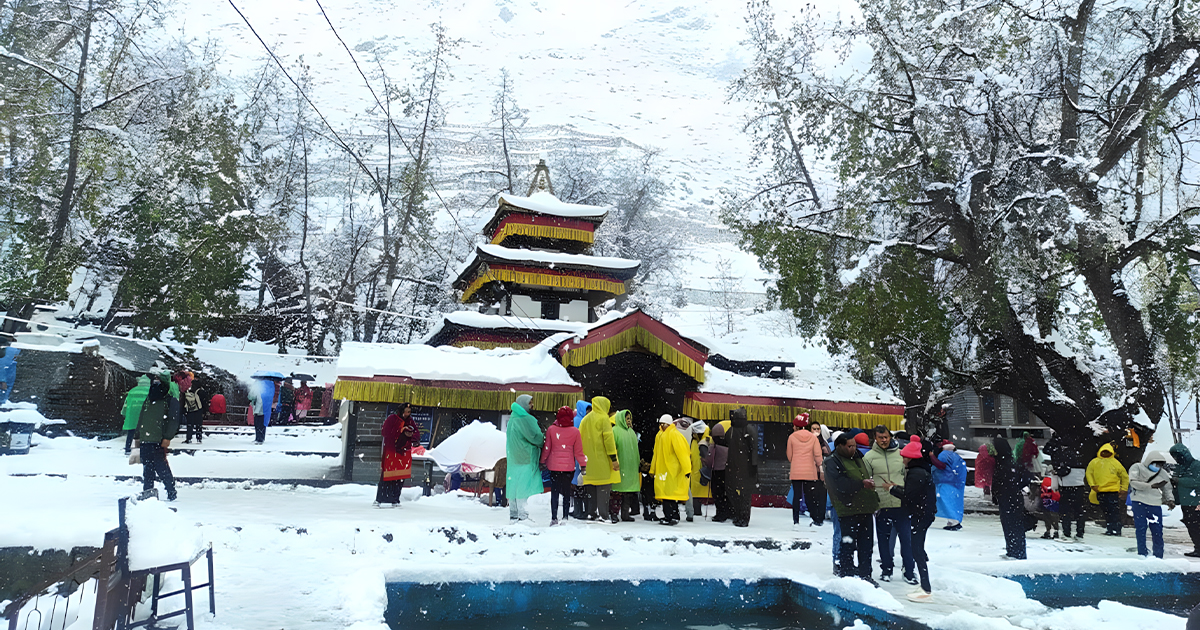
Witness the magical snowfall at Muktinath Temple
Historical Importance of Muktinath Temple
Each and every corner of this temple carries centuries-old myths and legends. The temple’s architecture and the statue of the gods make you feel the weight of history. Muktinath Temple has been mentioned in several ancient Hindu epics, like the Ramayana, and in the Barah Purana.
Another popular ritual done by pilgrims is to bathe under the 108 sacred water spouts and pray by the eternal Jwala Mai flame. They believe doing this cleanses one’s soul from past sins and grants moksha (liberation). Therefore, it is also Chumig Gyatsa in Tibetan, which means “Hundred Waters” from the 108 water spouts in its courtyard.
The central idol of Lord Vishnu inside the Muktinath Temple is said to have been made in the 16th century. It has been here since medieval times or earlier. Later in 19th century, a temple was built to protect the statue of Lord Vishnu. There is a myth that says the statue of Lord Vishnu appeared on its own or was carried here by yogis.
The most interesting fact is the idol of Vishnu. It is made from black stone found in the valley below, on the bank of the Kali Gandaki River. These black stones are ammonite stones called “Shaligram”, which are naturally fossilized snail shells sacred to Vaishnavites. Therefore, it is said that the idol is made from the shaligram stone itself found on the bank of the Kaligandaki River. And the fact is, Lord Vishnu’s form represents Shaligrams.
Similarly, the well-known flame “Jwala Mai” located near the cave called Jwala Devi Temple of Muktinath Nepal never goes out. This has attracted the eyes of the pilgrims. Many visit there to see it, believing it to be divine and purifying.

Muktinath Temple under a blanket of snow
An interested traveler can go and perform the traditional ritual of lighting a butter lamp and ghee on that flame, and offerings of sheep wool (in old days) to feed the fire. This eternal fire represents the fire element of the universe’s five great elements according to Hindus.
On the other hand, Buddhist devotees say that Guru Padmasambhava, the founder of Tibetan Buddhism, passed through Muktinath on his way to Tibet. He is also called Rinpoche. The Tibetans also believe dakinis, sky-dancers, semi-divine Tibetan goddesses, dwell here.
Who built Muktinath Temple?
Till today, nobody knows who built the Muktinath Temple Nepal. Due to the lack of evidence of recordings on the Muktinath Temple’s history, it is unknown which specific king or builder constructed it. The structure of the current temple is said from 1the 9th century, so one of the rulers of the Shah or Rana kings of Nepal in the 1800s could be the one.
On the other hand, the gold-plated idol Vishnu‘s records the date states from the 1500s. This makes us believe the older temple stood on this site well before then. There is no officially recognized founder and only rumors of some saying it could be by from medieval Mustang rulers or even visiting Indo-Tibetan yogis. In any case, devotees considered the Muktinath Temple as self-manifested and divinely appearing.
What is Muktinath famous for?
Besides the famous corridor of 108 carved bull-heads taps, Shaligram’s Vishnu idol, and blue flame, Mustang Muktinath temple is a paradise for travelers and explorers. Thing that makes Muktinath Nepal famous and one of the must-visit sites are given below:
- 108 Water-Spouts (Mukti Dhara): The bull head 108 taps built in a semi-circular wall in back of temple’s courtyard are one of the major highlights. This water is fresh, and snowmelt flows all year-round. Pilgrims line up by dawn and run through the 108 taps just to bathe, as they believe bathing from the tap cleanses the soul. It is also the main reason why this temple is called Mukti (liberation) Dharma site. The 108 number of taps carries a deep spiritual meaning. In Hinduism, it is taken as 108 chakras and 108 pilgrimage sites, so bathing through these water-taps is like walking on the path of liberation.

The sacred 108 Dhara of Muktinath — a divine cascade of purity and devotion.
- Eternal Flame (Jwala Mai Temple): This temple is very famous for having the ever-burning flame. It’s not that far, just a short walk from the main temple, where you can see the fire which never goes out. It is caused by the natural gas seeping through cracks. This is the main reason that caused the fire to burn continually for centuries without going out. Pilgrims come here to light the lamp and offer butter or clothes as a ritual and to receive blessings because they think this flame is a manifestation of the divine god. Similarly, Hindus and Buddhists believe it is one of the five elements: earth, water, fire, air, and sky.
- Golden Vishnu Idol and Shaligram Stones: The temple houses the beautifully crafted black stone idol of Lord Vishnu, gilded in gold. There is a belief, the statue of Vishnu was made of ammonite fossil stone from the nearby river Kali Gandaki, called “Shaligram.” Similarly, Muktinath is taken as one of the only 108 Divya Desams in Nepal outside India’s holy grounds.
- Dual Pilgrimage for Hindus and Buddhists: This temple is revered by both Hindus and Buddhists. For Hindus, they worship Vishnu, and Buddhists worship Chumig Gyatsa (“Hundred Waters”) as they believe it resides in God Avalokiteśvara (Chenrezig). Likewise, the main priest of the temple also has both Buddhist monks and Hindu Brahmin priests. Inside the temple, you will witness both Buddhist and Hindu pilgrims circling the temple and worshipping together.
- Mustang Scenery: The best part of the Muktinath Temple trip is the landscapes and views. This temple is located in the Mustang district. This district is one of the most popular tourist destinations in Nepal. The surrounding views of high snow-capped mountains and the surrounding are unbeatable. The temple is built very high in the mountain and is isolated from the outside world. From the top of the mountain, you can enjoy the view of barren hills dotted with traditional Tibetan-style villages, the Annapurna and Dhaulagiri ranges towering above the temple. Each corner of this place is picture-perfect. The view of rocky terrain covered with snow and glistening snow over the peaks is just wow. So, if you are nature-lovers, you won’t regret visiting Muktinath Nepal.
- Festivals and Rituals: It is best to visit during the festival season, as you can experience their culture and tradition firsthand. Therefore, thousands of pilgrims visit the Muktinath Temple. They especially come here during the festival Janai Purnima to bathe from 108 water spouts and renew their holy cords.
Besides being a holy site, Muktinath is perfect in every aspect. This beautiful temple is blessed with divine energy and breathtaking nature. This Himalayan pilgrimage is worth every second as it is full of culture and tradition, which provides a beautiful experience to those who love exploring new things.
Muktinath Mandir Architecture & Timings
The simple pagoda structure made from wood makes the architecture of Muktinath beautiful. Its structure is in a typical Nepali Hindu temple style with a pagoda roof and gilded finial. Inside the temple is a pure gold Vishnu murti (idol) which is at human height. The area of Muktinath temple is medium, and around the courtyard are has few statues of gods Ganesh, Shiva, and a Buddhist monastery (gompa) a few steps away. The temple is decorated with prayer flags, tied by Buddhist pilgrims.
Similarly, on either side of the temple were two holy ponds. Here, you will see dozens of brass oil lamps and reflections of mountains. If you visit during the day, you can see the beams of light creating a beautiful effect on it.
The opening hour of the Muktinath temple is early in the morning, around 5:00 am every day. The closing time of the temple is in the evening, around 8:30 pm every day. So, make sure to visit during this time; otherwise temples will be closed beyond this allocated time.
Due to the high location, the dawn comes as early as 4:30 in summer, and in winter it comes late, around 6:00 am. Make sure to dress warmly as it gets very cold in the morning and at night.
Weather & Temperature in Muktinath Temple
Muktinath Temple is located at a height of 3,762 m (12,343 ft). This much height makes the weather chilly almost every year. During the winter, it gets risky due to the heavy snowfall and slippery making it impossible to visit. Therefore, we suggest you visit Muktinath Temple during the peak season only. With good preparation, everyone can complete this adventure safely and comfortably.
- Summer (May-June): In the mountainous region, summer days are mostly warm, sunny, and comfortable. The temperature ranges from 12 to 20°C. Though night brings quite chilly temperatures dropping to 5°C. From May to June is the peak and best season for visiting the Muktinath temple.
- Monsoon (July-Sept): Mustang district sits in a rain shadow. This causes rare rainfall in the region. The skies and surroundings get dry and have desert-like landscapes. The temperatures fall between 10 to 18°C. Though it’s not the worst time to visit, but lower region along the trail experiences monsoon rain, causing muddy and slippery roads. We suggest you check trail updates before visiting.
- Autumn (October-November): It is the peak season for visiting Muktinath Temple and trekking in Nepal. The post-monsoon weather brings crisp air, clear skies, and dry surroundings. The temperature also gets comfortable, ranging from 10 to 15°C. At night, it drops to near freezing point. The surrounding peaks get covered with snow, and it also falls during the festival time (Janai Purnima is late August/September). The visibility and cozy weather make the journey perfect.
- Winter (Dec-Feb): It’s not the best time for visiting the Muktinath temple because of heavy snowfall and harsh cold temperatures. The temperature is as low as 5°C or colder at night. During the day, it goes up to 5°C or so. Similarly, mountain passes and jeep roads also mostly get closed due to snowfall.
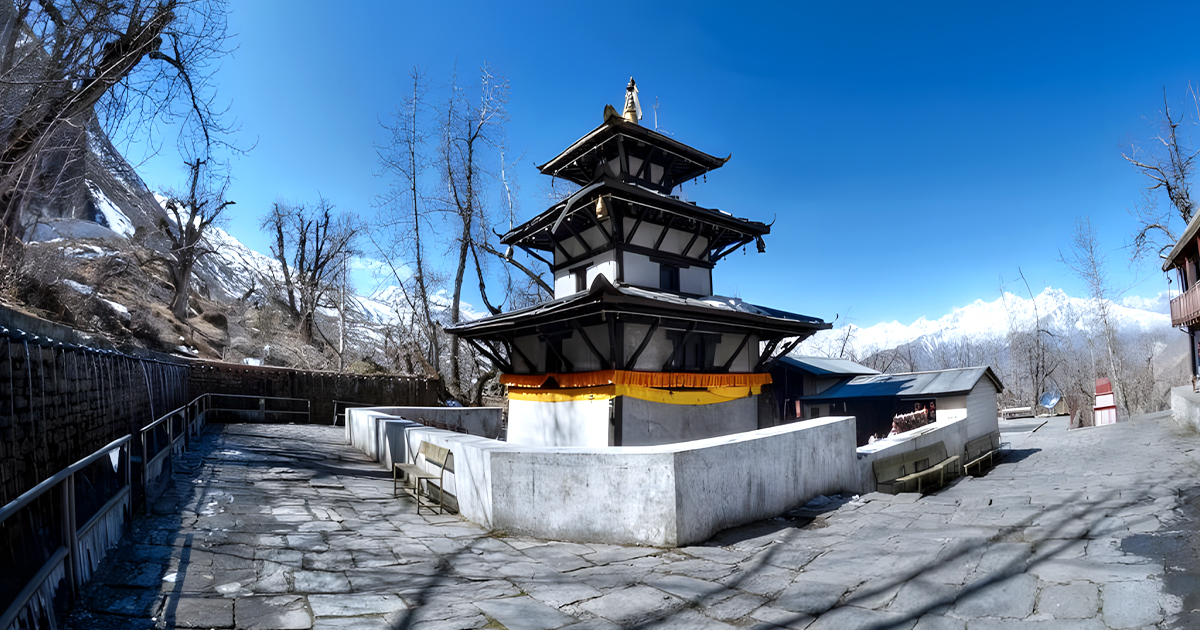
Peaceful Muktinath Temple photo showcasing its spiritual charm amidst the Himalayas
Altitude Sickness Muktinath Temple
One of the major challenges when visiting Muktinath Temple is altitude sickness. Nearly 4,000 m above sea level, the air consists of 60% oxygen. This might cause a slight headache or shortness of breath. If not traveling properly, there is a high risk of getting altitude sickness
To prevent altitude sickness, walk gradually, drink enough water, include acclimatization days ( at Jomsom, 2,720 m), avoid alcohol, sleep properly, and eat nutritious food.
Most importantly, don’t push yourself too hard if you are feeling discomfort or even unfit. If you experience common symptoms of altitude sickness like headache, nausea, weakness, difficulty in breathing, inform your guide and descend. Only a slow and steady trek gives a successful trek as a result.
Photo Session Spot in Muktinath Temple
Many believe that since it is high and cold, sunlight exposure will be less. But that’s not true, the higher you climb more you are exposed to intense sunlight. We suggest you carry sunscreen and long-sleeved clothes that give you full coverage
Furthermore, nights are very cold. Do not forget to bring a warm winter hat and a down jacket. If you are trekking with Access Nepal Tours and Trekking, we provide down jackets and sleeping bags to use for free. Thermal clothes and gaiters are also needed. The best tips are to wear layers like an onion during the visit.
Best Time to Visit Muktinath Temple
For a safe and memorable journey, choosing the best time is extremely essential. March-June and September-November are the best times to visit Muktinath Temple. These months are also peak seasons for trekking in Nepal. If you trek during this season, you will experience great views, clear skies, and mild temperatures. Though expect some crowds if you are trekking during the peak season.
Trekking during the late winter (March) and early monsoon (July) is also possible. If you trek between July and August, you will see green fields and fewer crowds along the trail. However, if you prefer more comfort, peak season is best, and want to experience the festival, August fits perfectly.
It’s best to avoid visiting during the winter (Dec-Feb) because of extreme cold and heavy snowfall, passes might get closed, and many lodges may not be open. Similarly, during the monsoon peak (late July), there is a chance of hailstorms and muddy roads at lower elevations. Though Mustang district and Muktinath are relatively dry.
Daily climate at Muktinath changes rapidly and is unpredictable. It’s best to travel after checking the weather
Temperature Chart of Muktinath Temple:
The temperature at Muktinath Temple changes quickly and is unpredictable.
- During April to May, it gets about 15-18°C during the day and drops to 0-5°C. at night.
- During the August monsoon, the temperature goes up to 17°C and lows to 8°C at night.
- During peak season, the daytime temperature gets 12°C and nights drop to -2°C.
- In winter, the temperature drops to 4-6°C during the day and plunges to -5°C at night. So always have warm layers, and a warm sleeping bag or blankets are vital in winter.
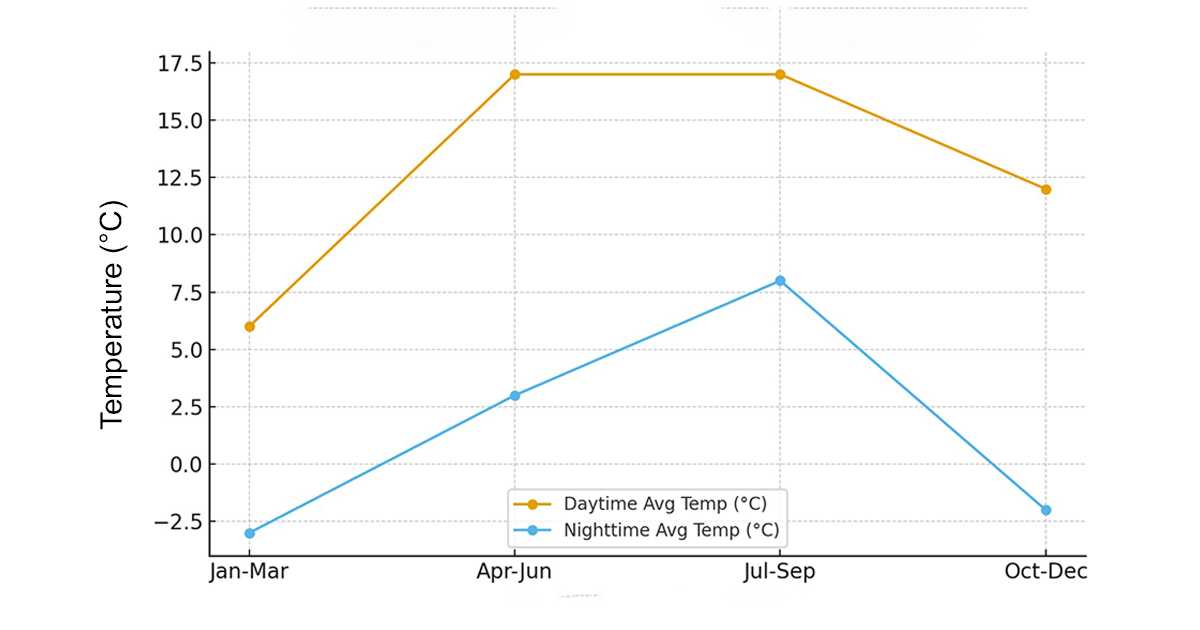
Muktinath Temple temperature chart to understand seasonal changes, from snowy winters to mild summer days.
What to carry for the Muktinath Trip?
The key part of traveling is packing. The first thing to consider while traveling is to pack smartly and lightly. To make it easy, we have made a list on what to pack which covers all the essentials.
- Thermal underwear
- Wool/synthetic layers
- Fleece jacket
- Down Jackets (provided for use free of cost)
- Windproof/waterproof shell
- Hat/beanie and winter gloves
- Moisture-wicking shirts
- Sleeping bag (provided for use free of cost)
- Hiking pants
- Thick socks
- Sturdy hiking boots (broken-in)
- Pair of sandals
- High-SPF sunscreen
- UV-blocking sunglasses
- Wide-brim hat
- Lightweight rain jacket
- Water bottles
- Snacks
- Personal meds
- Hand sanitizer
- Flashlight/headlamp
- A camera with extra batteries and a power bank
The best suggestions is to pack light ayer in summer along with good boots, add waterproofs on monsoon, add a down jacket in ; autumn, and add heavy gear in winter.
Getting to Muktinath: Distance & Routes
Muktinath Temple is very far away from Kathmandu. It can be done via bus, jeep, or car through Pokhara and the Himalayan valleys. The distance between Kathmandu to Muktinath Temple is about 400km. The drive takes over 11h7m.
The route starts from Kathmandu, then to Pokhara, either via a 15-minute flight or 8 hrs bus drive. From Pokhara, drive through the north along the Kaligandaki Gorge and leading to Muktinath Temple.
Another alternative route option is: Kathmandu → (30-minute flight) Pokhara → (fly or drive) Jomsom → (jeep/trek) Muktinath.
- By Air: This is the fastest route to reach Muktinath Temple. Fly Kathmandu→Pokhara (25 min), then Pokhara→Jomsom (25 min). After reaching Jomsom airport (2,720 m), you have to take a jeep drive up to Muktinath. It covers 23 km, taking 5 to 6 hours. However, fights can get delayed or canceled due to weather. So, amend your itinerary accordingly.
- By Road: It is the most popular route. It’s an off-road drive full of adventure. You can directly take a local bus from Pokhara to Muktinath. For more comfort, private tourist vehicles are also available. The total distance is 180 km from Pokhara to Muktinath. The route passes through the green hills to Beni, then drops down into the Kali Gandaki Gorge, passing Marpha (famous for apples and apricot brandy). The road is paved with gravel and with lots of twists and turns
- Trekking Routes: The Muktinath Temple falls along the classic route to the Annapurna Base Camp Trek and the Annapurna Circuit Trek. Most itineraries taking the Annapurna trek have stops at Muktinath Temple. The route usually starts from Besi Sahar or Chame and treks over Thorong La Pass to Jomsom.
- Horse Ride in Muktinath: This route is for adventure seekers. Trekkers can choose to reach Muktinath on horseback from Jomsom. After paying some amount, you can easily hire a pony or horse to carry you or your pack up to Muktinath (about 23 km). The adbetute takes you past Kagbeni and Jharkot, into the heart of Mustang, and finally arrives at Muktinath. However, it might be time-consuming and physically hard. But if you want to experience an authentic Himalayan traveling lifestyle Horseback ride from Jomsom to Muktinath Temple is not bad.
Muktinath Temple Travel Guide
To enjoy the trip fullest without missing anything, you will need some tips. Taking a trip to Muktinath Temple is less hard than doing the Everest Base Camp Trek or the Annapurna Sanctuary Trek. Below, we have listed some practical travel tips for safety and adventure:
- Acclimatization Days: When trekking at high elevation, acclimatization tips are key. Racing straight from Kathmandu (1,400m) to Muktinath (3,800m) is not recommended. Sudden altitude gains trigger your body’s oxygen level, leading to altitude sickness. Therefore, including a rest stop before climbing to high elevation is suggested. Include acclimatization days at Pokhara at 820 m, then Jomsom at 2,700m. This gives enough time for your body to adjust to the altitude. Throughout the trip, drink lots of water and avoid alcohol. Exploring around and going for a short hike at rest stops helps with headaches and fatigue.
- Dress in Layers: Muktinath is located in a high and cold place. It has very windy and harsh cold weather. To avoid getting sick, bring warm fleece or down jackets, thermal suits, and a windproof outer layer. Winter hat, gloves, and sunscreen are mandatory. Also, buy a high-quality trekking boots with good ankle support and grips. Morning and evening are especially cold, so be mindful when going out during those times. During the trek, do not take off your clothes even if you feel hot.
- Footwear: Bring a couple of socks to change into during your visit to Muktinath Temple. It is not allowed to walk around the temple wearing shoes. So, to not get cold socks, help to keep feet warm.
- Packing List: Bring the essentials mentioned in our packing list. Things like water bottles, a power bank, lip balm, and toilet paper will be needed.
- Physically Fit: Make sure you are physically fit and in good health and good condition. If you have an illness related to asthma or the lungs, this journey is not recommended. It will be best to consult with your doctor if you have any illness before traveling. If you are taking any kind of medication, make sure to carry it with you.
Nearby Attractions in Muktinath Temple
Beyond the Muktinath Temple, this place has lots of other gems. If you have enough time, it is worth checking out these beautiful places:
- Jwala Mai Flame Temple: To reach Muktinath Mustang Nepal, and come back without visiting Jwala Temple is no fun. This Jwala Temple is built on a rocky hillside. Divided into three chambers with burning flames of Earth, Water, and Gas. Pilgrims from all over the world come to see this eternal flame. Just 5 to 10 minutes away from the temple, it’s worth checking out. The blue flame flickering against the ancient stone is so good.
- Kagbeni & Jharkot: Kagbeni village (2,870 m) falls on the way to Muktinath from Jomsom. This village is one of the oldest and ancient, which is known for having stone houses and Buddhist stupas. From here, you can also capture photos of the Kali Gandaki River canyon. Built on the high hill is a village called Jharkot, which has an old monastery. From here, you can enjoy the panoramic views of Mustang.
- Alpine and Pilgrim Lakes: If you want to add more adventure and memories, traveling beyond Muktinath is another great option. The route beyond here is are popular trekking route leading to Damodar Kunda (4,780 m) or Tilicho Lake (4,919 m), which is one of the highest located lakes in the world.
- Local Festivals: If you want to know more about the mountainous lifestyle in an authentic way, visit during the festival season. Some of the local festivals of this region are Janai Purnima (Aug), Rishi Tarpani (Aug-Sept), and the Tibetan New Year (Losar, usually Feb). Similarly, every full moon, rituals and celebrations are performed at Muktinath Temple.
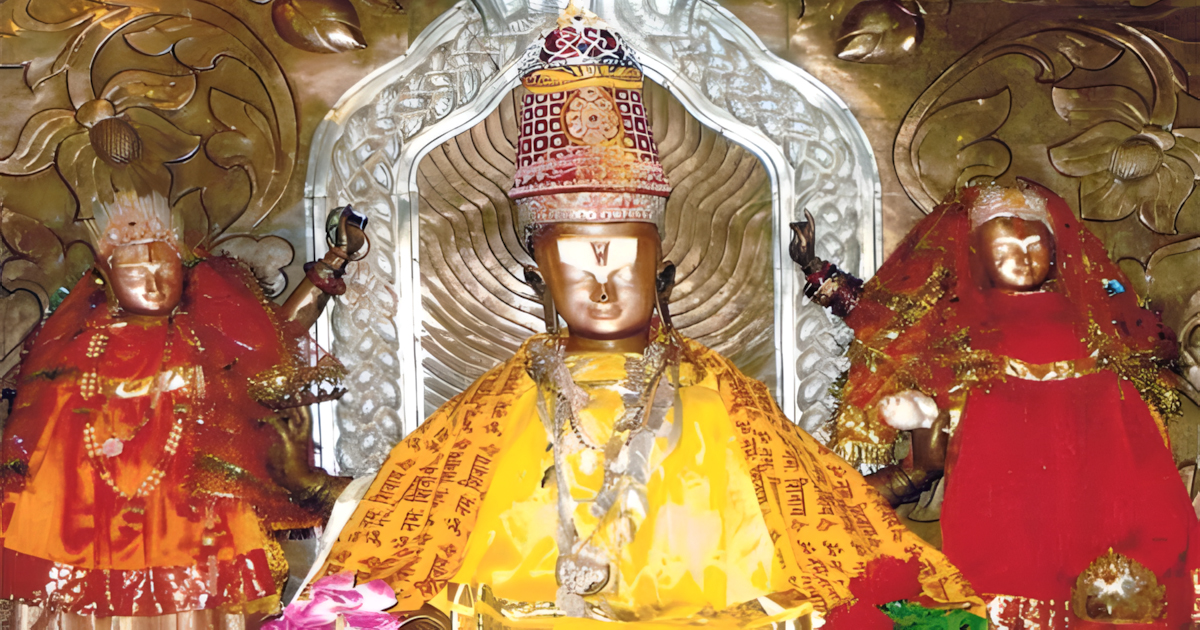
Divine energy of Lord Vishnu at Muktinath Temple
This place is truly a nature and culture treasure trove. Enjoying the local production like Marpha (famous apple brandy and local honey brandy (Chhang) at a teahouse is quite fun. Mustang is also known for producing very sweet and good-quality apples. So, the adventure to Muktinath is full of beauty.
In Which District Muktinath Lies?
Muktinath is inside the Mustang District, a famous tourist hub in Nepal. This beautiful, culturally rich Himalayan region is also known as the “Hidden Kingdom.” The major town in this district is Jomsom, which is known for having traditionally built stone houses. This town is best for acclimatization before going up to the Muktinath Temple. It has lots of hotels, cafes, bars, and a bakery.
Mustang District is divided into Upper Mustang and Lower Mustang, covering the Kali Gandaki valley. Likewise, the temple falls inside the southern side of Upper Mustang’s border.
FAQs on Muktinath Temple
Where exactly is Muktinath Temple?
→ The exact location of Muktinath Temple is Mustang District, Gandaki Province, Nepal.
What is the height of the Muktinath temple?
→ The Muktinath Temple height is 3,800 meters (12,470 feet) above sea level.
Which god is in Muktinath?
→ God in Temple Muktinath is of Lord Vishnu. It is regarded as one of the holiest temples by Hindus.
What is Muktinath famous for?
→ Muktinath is famous for having a main idol of Lord Vishnu of pure gold, 108 holy taps, and an eternal flame. Thousands of Hindus and Buddhist pilgrims visit this temple to receive liberation.
How to reach Muktinath from Kathmandu?
→ You can reach Muktinath either by flying to KTM to Pokhara, then to Jomsom, or by driving from Kathmandu to Pokhara and Jomsom.
Distance from Kathmandu to Muktinath?
→ The Kathmandu to Muktinath Temple distance is 400 km by road. It takes more than 11 hours to drive there. Therefore, travellers usually include rest stops at Pokhara and Jomsom.
When is the Best season to visit the Muktinath temple?
→ The peak season to visit Muktinath is spring (March to June) or autumn (September to November). During this time weather gets warm along with dry trails, and clear surrounding views. During winter and Monsoon is also possible, but it will be risky.
What is the oxygen level in Muktinath Temple?
→ The oxygen level in the Muktinath temple is around 60%. Therefore, this brings the challenges like altitude sickness. To prevent getting it, trekkers are recommended to acclimatize properly, walk slowly, drink plenty of water, sleep properly, and avoid alcohol.
How many steps are there to Muktinath Temple?
→ There are 300 steps to Muktinath Temple. These stairs are stone-paved paved starting from the lower gate and the main gate.
To summarize, the Muktinath Temple pilgrimage has many things to offer. Located away from the crowd, this place is full of nature, culture, history, views, and tradition. This adventure is truly a lifetime experience. With ancient cultures and traditions, this adventure gives you the taste of rural Himalayan life. This trip is suitable for beginners and experienced trekkers who love nature.
If you want to trek with Access Nepal Tours and Trekking, just contact us through email or WhatsApp. All of our packages are all-inclusive and cover the cost of accommodation, food, transportation, meals, and permits. The Muktinath Mustang Nepal journey is worth every second. Filled with religious beliefs, spirituality, and those who are seeking peace, visit the Muktinath Temple.
Awards and Achievements
Access Nepal Tour and Treks has been recognized with TripAdvisor’s prestigious Travelers’ Choice Award for multiple consecutive years, reflecting our unwavering commitment to quality and clients’ satisfaction.













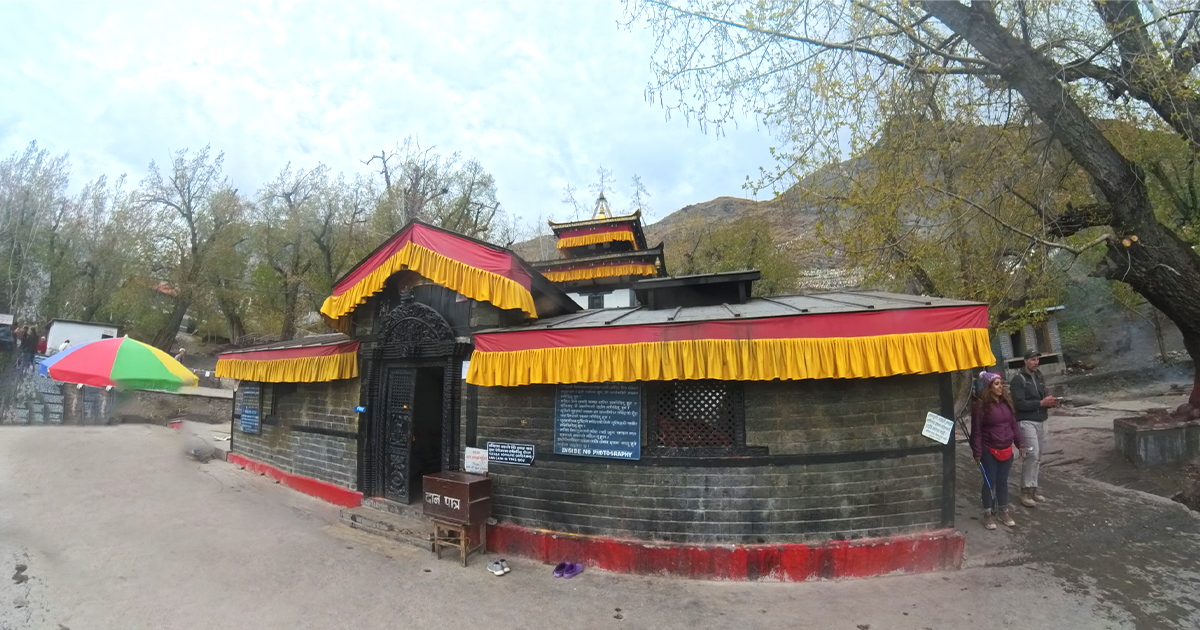



Leave Your Comment